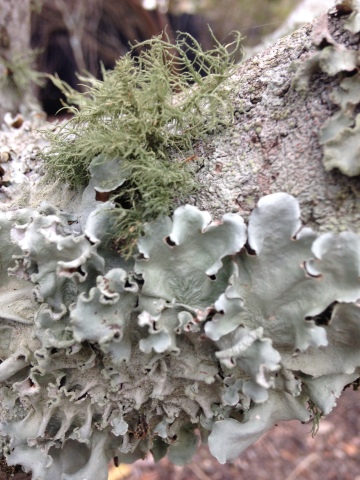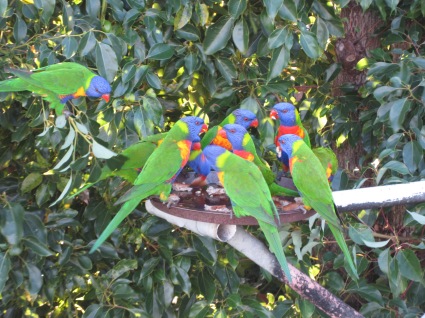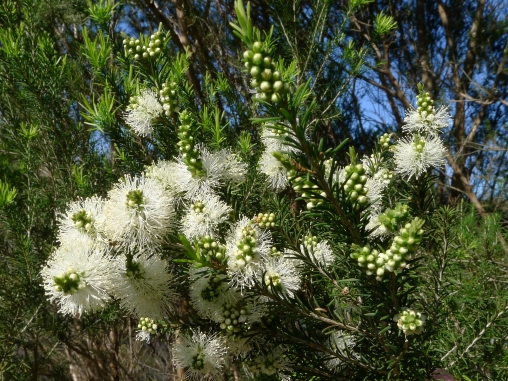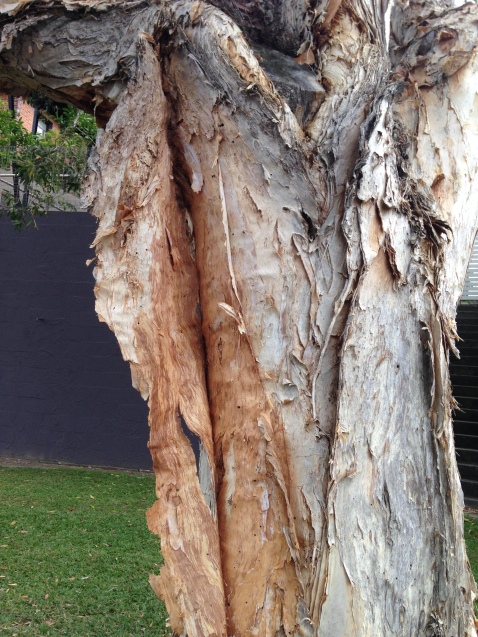
Lichens growing on a melaleuca branch.
At this time of the year in the Northern Rivers area of New South Wales where I live, the paperbarks or melaleucas, are shedding their bark. The soft texture and muted colours of the bark are gorgeous and once shredded, it makes great mulch for the garden.
I discovered that ‘Melaleuca is a genus of around 170 species in the Myrtle family (Myrtaceae) …The majority of species are endemic to Australia but several occur to the north [in places such as] Indonesia, New Guinea, New Caledonia, Malaysia.’ They are tough, drought and fire hardy trees usually found in swampy areas and along watercourses in open forests and woodland. They abound in the parks and gardens in my area. Related to the bottle-brush or callistemon genus, paperbarks share the same brush-like flowers so irresistible to Australian nectar eating birds like the Rainbow Lorikeet.

Rainbow Lorikeets

Creamy brush-like flowers of the paperbark
Most appealing to us when we were small, was the paper-like bark which we peeled off in large sheets from the trunks. The flaky layers were too soft to write on unless you used charcoal, but bugs of all kinds hid beneath and wrote their squiggly stories on the smooth fragrant underside
Australian Aborigines made extensive use of the paperbark for bandages, garments, sleeping mats and for wrapping food for cooking. It was even soft enough to line the inside of babies’ baskets. The Aborigines built shelters called Bayu (pronounced Ba-Yoo), using overlapping sheets of bark to cover frames of bent ‘wait-a-while’ canes, so called for their hooked spines. A small fire was set outside the shelter which, combined with the scent from the paperbark, produced a mosquito repelling smoke. Once you’ve experienced its lemon scented perfume, you’ll never forget it.
 The paperbark was also important for Aboriginal medicinal, symbolic and spiritual use. Some clans used the leaves for their anti-bacterial qualities. Some for smoking ceremonies to cleanse, heal or dispatch harmful spirits. The distilled essence, known as Tea-Tree oil, is available over the counter at pharmacies today for the same purpose. It was standard issue to World War II soldiers for its wide spectrum use as a mouth wash, antibacterial, anti-fungal lotion, and insect repellent, among other things. It’s a stock standard in my medicine cabinet as well. Smudge sticks made of melaleuca are sold in some alternative lifestyle shops to repel harmful spirits. The bark was believed to possess natural spiritual and magical properties.Bodies were wrapped in paper bark for Aboriginal funeral ceremonies. Imagine that. No negative impact on the environment.
The paperbark was also important for Aboriginal medicinal, symbolic and spiritual use. Some clans used the leaves for their anti-bacterial qualities. Some for smoking ceremonies to cleanse, heal or dispatch harmful spirits. The distilled essence, known as Tea-Tree oil, is available over the counter at pharmacies today for the same purpose. It was standard issue to World War II soldiers for its wide spectrum use as a mouth wash, antibacterial, anti-fungal lotion, and insect repellent, among other things. It’s a stock standard in my medicine cabinet as well. Smudge sticks made of melaleuca are sold in some alternative lifestyle shops to repel harmful spirits. The bark was believed to possess natural spiritual and magical properties.Bodies were wrapped in paper bark for Aboriginal funeral ceremonies. Imagine that. No negative impact on the environment.
Sometimes I think we’re barking up the wrong tree.
Old ways have endured for hundreds of years because they were effective. I’m not idealising the past but merely posing a question. Perhaps we should be growing the melaleuca tree for the funeral industry as an alternative to the expensive and environmentally unfriendly coffins currently used? Tea-tree oil endures because it’s effective and economically productive. Who knows what other uses we might find for the wonderful paperbark tree? The argument for their viability will be: will they serve at the capitalist altar?
“It’s not about what it is, it’s about what it can become.”
― Dr. Seuss, The Lorax
I love this idea!
LikeLike
Thanks Nancy. There is so much unnecessary waste. It feeds industry in its worst possible incarnation.
LikeLiked by 1 person
Agreed
LikeLiked by 1 person
The paperbarks are one of my favourites. When I was out riding early morning this week, their sweet scent swept past me. It was beautiful!
But they’re also a very functional tree and, as you suggest, there are probably many uses that we overlook.
LikeLiked by 1 person
That’s right. When I began to look at how useful they were to Aboriginal people I was amazed. The good thing is they didn’t add to landfill, pollute with petro-chemicals, or require excessive amounts of carbon producing manufacture. They’re the ultimate throw away renewable.
LikeLiked by 1 person
I just love what I learn from you Robyn. I use tea tree oil but had no idea where it came from. thank you
LikeLiked by 1 person
So much the case with a lot of what we use Brenda.
LikeLike
Thanks for a very informative post. I’d come across tea tree as an antiseptic oil but knew nothing about its relatives. It’s a great picture of the meeting of Lorikeets too.
LikeLiked by 1 person
Thanks Judith! I shared my former home with an abundance of birds. We lived on the periphery of a wild life sanctuary right near the beach. Gnerations of children delighted in feeding the birds each evening oon the bird tray you see there. The pythons (non-venomous) used to hang in the tree waiting for unsuspecting rodents who came to clean up the scraps. It was great for the kids to experience. The tea tree oil is a wonderful all purpose antiseptic to have in the medicine cupboard. We can learn so much from our indigenous peoples
LikeLiked by 1 person
I hadn’t heard of the paperbark trees before, but they sound very useful. I’ll bet there probably are a lot of great potential uses to which they could be put.
LikeLiked by 1 person
Yes that’s what I think Bun.
LikeLiked by 1 person
Such beautiful photos! I can almost smell the bark. Maybe someone will use this post to start a new business…
LikeLiked by 1 person
Thanks Rachel! The leaves are amazingly fragrant when smoked. That’s what is used to distil the oil. I was just thinking of you and wondering how you were faring when the earth moved. I will read your new post about the quake shortly and find out.
LikeLiked by 2 people
I think it would be nice to lie in a melaleuca coffin for a bit, and then get up. I am now going in search of this as an insect repellent . Much better than chemicals, I agree.
LikeLiked by 1 person
Tea-tree oil is good for so many things. I hope you can source some. As for the melaleuca bark, I was thinking it could be used as a kind of shroud – no coffin needed. Wrapping people at both ends of their life. I agree. It’s way too early for you. 🙂
LikeLiked by 1 person
Yes, but that shroud idea sounds cozy.
LikeLiked by 1 person
As always this is an informative post with lovely photos. I just saw a picture of a Rainbow Lorikeet on Facebook the other day. They are so colorful.
LikeLiked by 1 person
They are Steph. And so funny to watch. They have lots of personality.
LikeLiked by 1 person
Okay now I’m going to search for them on video to see their antics.
LikeLiked by 1 person
Oh my goodness, I found one named Poppy who’s quite verbal and playful. She’s adorable.
LikeLiked by 1 person
I always wondered where tea tree oil came from, now I know. Thank you. As I read your post I kept thinking about Madrone trees (Arbutus menziesii). I saw these once when I was travelling in the San Juan Islands near Seattle in the USA. I never forgot them: deep reddish bark which peels off showing a bright green layer underneath. The peeled bark is strong and pliant if I remember correctly. The bark was also used for stomach ailments and other medicinal purposes by Native Americans in the past.
LikeLiked by 1 person
I love your story about the Madrone trees used for indigenous medicine. I recall something like that when I was there many years ago. I’m going to look it up. Thanks for visiting.
LikeLike